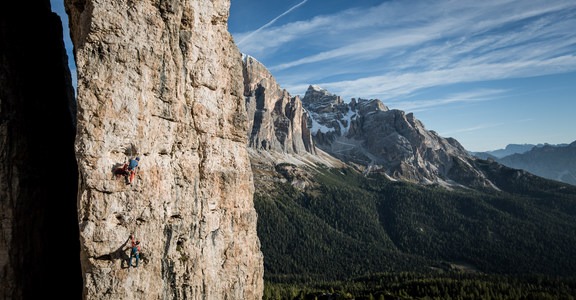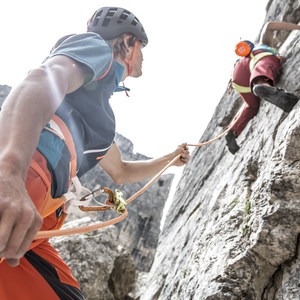Staying safe with the right equipment
You can’t climb without equipment. And if you go alpine climbing, you’ll need even more equipment. Alongside your personal ability and the conditions, having the correct high-quality equipment is a key variable in mountaineering. Mountaineering equipment is therefore subject to various standards with which it must comply. In addition to the European Standard (EN), there is also the UIAA standard (Union Internationale des Associations d’Alpinisme), which has become the global benchmark.
From helmets to climbing boots: The basic equipment required for alpine climbing is more extensive than for sport climbing at an indoor climbing wall or single pitch crag. Depending up the climbing tour, the equipment required may vary or be supplemented, but the basics for each team remain the same.
Harness
Whether for sport climbing on a rock face, in the ice, on alpine tours or on a high-altitude tour, a climbing harness is the key piece of equipment. There is a wide variety of harnesses on the market, all with different properties according to the application.
- Hip belt: Roping up with a hip belt for climbing is in line with the consensus of the Alpine Club. But there are small differences between the harnesses used in sport climbing, on high-altitude tours and in alpine climbing: while harnesses for sport climbing have fewer equipment loops, these are crucial for alpine climbing. There needs to be enough loops for quickdraws, various types of protection gear, materials to build belays, etc. Padding is less of a priority for alpine climbing than for sport climbing, as falls are largely avoided on alpine rock faces. Nevertheless, the harness should fit optimally and the straps at the back of the leg loops and on the hips should be wide enough, otherwise the harness will become uncomfortable and painful in a hanging position or during long rappelling. In comparison, hip belts for high-altitude tours, which were not designed to be worn for long periods of time, do not have very wide straps, and are hardly padded at all. However they do have a minimal packing size and are extremely light.
- Chest strap: A chest strap is supplementary to a hip belt and may only be used in combination with it. In the event of a fall, it should prevent the climber from turning upside down – although the likelihood of turning is generally low anyway. A chest strap is useful when climbing with a very heavy backpack or excess weight.
- Full body harness: In the past, full body harnesses were mainly used on alpine or high-altitude tours. Today they are predominantly used in industrial climbing or as a small body harness for children who do not yet have fully developed muscles. They are not used in alpine or sport climbing, as it makes falling uncomfortable due to the hanging position of the harness.
Helmet
Helmets have two purposes in mountaineering and alpine climbing: protecting against falling rocks and protecting against impact. Traditional mountaineering helmets have a plastic shell, making them robust but limited in terms of side impact protection. Modern in-mold helmets are comparatively light, as they are made up of a polystyrene core with a relatively soft outer shell. They provide optimal protection from impact but are more fragile due to their construction. Hybrid helmets aim to balance out the advantages and disadvantages of plastic and in-mold helmets: The foam construction is covered with plastic. Hybrid helmets provide good protection, but are still lightweight.
Climbing Shoes
All climbing shoes have tread-less soles in order to create friction on the rock and to ensure precise steps. The various models differ in the hardness of their soles, their tension and their shape. Climbing shoes should be selected based upon their intended use. There is no such thing as a perfect all-rounder that can handle everything from bouldering problems to 20-pitch alpine tours.
On alpine routes where climbers can’t take off their shoes after every pitch, better wear comfort is required than in sport climbing, for example. Climbing shoes for alpine tours are therefore not as tight and have less or hardly any pre-tensioning. However, they also need to fit closely enough on slabs or on vertical climbs to allow precision climbing.
Belay and rappelling equipment
- HMS (pear shaped) carabiner: An essential component of your equipment! There are basically two different types of HMS carabiners: carabiners with secured locking systems (SafeLock carabiners) and those with unsecured locking systems (screwgate, twistlock). The former is mainly used for roping up on glaciers or on a top-rope, as it prevents accidental opening due to rope friction. Unsecured HMS carabiners are used on alpine tours: They have a large opening that is ideal for protection, belaying or rappelling.
- ATC - Dynamic braking devices are used in alpine climbing for protecting, belaying and rappelling. They generate the braking force through manual force on the brake rope. Semi-automatic belay devices like the Grigri and the Smart work differently. In these, the passage of the rope is automatically stopped in the event of sudden fall tension.
Chalkbag and chalk
Chalk predominantly consists of powdered or liquid magnesium, which causes the hands to dry out. Sweat moisture is absorbed, providing better grip on the rock.
Slings
In mountaineering, slings are used on intermediate belay points or to connect fixed points. Slings must be knotted or sewn independently and are usually made of polyamide (nylon) or Dyneema. Sewn slings are also known as quickdraws. These sewn slings are used in alpine climbing on belays or as intermediate belay points (“alpine quickdraws”). The advantage of alpine quickdraws is that they can be extended quickly as an intermediate belay point in order to reduce rope friction.
HMS and screw carabiners
A traditional HMS carabiner has a large opening and takes its name from the abbreviation of the German term for the munter hitch, ‘Halbmastwurfsicherung’:
The HMS carabiner can be used with a munter hitch to belay both the lead and second climber, but it is also used as a clove hitch for self-belaying and rappelling. In contrast, screw carabiners have smaller openings and are used less in (self-)belaying.
Snap carabiners
Snap carabiners are vital links in alpine climbing. They connect the rope to the hook or the traditional climbing equipment in the wall. Climbing carabiners are made of aluminum alloys and are fitted with either a straight or curved catch. Like HMS and screw carabiners, snap carabiners have to comply with a specific standard in terms of their minimum holding force.
Dyneema or Kevlar cords
Cords are made from polyamide, polyethylene (Dyneema) or aramid (Kevlar). Although polyamide is extremely tear-resistant, it is weaker than Dyneema or Kevlar, which is why it has to be thicker and heavier so that it meets standard requirements. However, the advantage is the elasticity, which can absorb a lot of energy.
Dyneema is highly tear-resistant and light. It has the highest cut resistance, but it is not very elastic. Kevlar has essentially the same properties as Dyneema but is a bit heavier in comparison.
Note that knotting reduces the strength of the cord material. Depending on the knot, the loss in strength could be 25 to 50%. At the same time, being suspended in a carabiner also reduces the cord’s break resistance.
Cell phone
A cell phone is an essential element of your basic equipment in order to call for help and make emergency calls.
Note that the operating life of all items of equipment made from plastic or textiles is maximum 10 years. Belts, ropes, helmets, etc. must be replaced after 10 years at the very latest – even if they have not been used. In the case of heavy wear, it is possible that items must be discarded far earlier – in extreme cases (e.g. a serious fall) after one use.
Check out the full series of Safety Academy Lab Rock videos below:
- Alpine basics
- Basic equipment for every climber
- Basic equipment for groups
- Additional equipment for groups
- Storms in the mountains
- Types of rock in the Alps
- Tour planning for alpine climbing
- Packing a backpack correctly
- Rope team procedures
- Knot techniques
- Belay using bolts
- Belay methods
- Anchors
- Coiling a climbing rope
- Rappelling
- What to do in an alpine emergency
- First aid on the mountain
- Rescue techniques while alpine climbing
- Bivouacking in an emergency situation
Visit ORTOVOX’s Safety Academy Lab Rock to view the climbing tutorials in their totality and test your knowledge with their fun and interactive quizzes.
Since the company was founded in 1980 in the south of Munich, ORTOVOX has stood for the highest possible protection during alpine activities. As pioneers in the avalanche safety field, we have played a key role in the development of emergency equipment for the mountains. Innovations such as the double-frequency avalanche transceiver and Smart Antenna Technology, and also targeted training measures, continue to be valuable contributions to making mountain sports a little bit safer and to saving lives.






Comments
Sign In and share them.